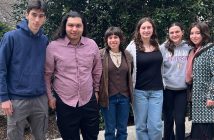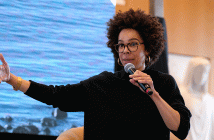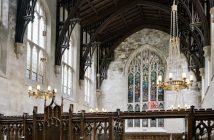Anne Mannion, Ph.D., associate professor of history, was a student at Fordham in the late 1950s, a time when female undergraduates could only attend the School of Education at 302 Broadway. Some 45 years later, she stands before her classes at Fordham College at Lincoln Center where women outnumber the men 3 to 2. With a record-breaking year in undergraduate admission and the addition of Marymount College as the University’s fifth undergraduate college, faculty members like Mannion are becoming increasingly reflective on the University’s past, present and future. “I loved Fordham as a student and still do,” said Mannion. “I don’t think I’ve gone to work a day in my life. I still consider it going to school.” Mannion recalls one of the more momentous changes within the University occurring with the addition of a residence hall at Lincoln Center in 1993.
She remembers that with McMahon Hall came a new kind of student: one that wanted a true Manhattan experience. Since then, as the school continues to grow and change, so too do the students. This year, Fordham University’s undergraduate applicant pool grew to 11,300, the largest in the school’s history. Since 1991, the applicant pool has grown by more than 200 percent.
The academic talent of the incoming class has once again increased with the enrollment of 10 percent more dean’s scholars and twice as many National Merit scholarship recipients than last year. John P. McCarthy Ph.D., professor of history and director of the Institute of Irish Studies, graduated from Fordham College in 1960 and, like Mannion, attended a very different University than the one at which he now teaches. “In my student days, there was no Lincoln Center campus and all the under-graduate students were male. Most of them were commuters with a significant per-centage being the children of immigrants, the first in their family to go to college,” said McCarthy, who attended graduate school and taught at other institutions prior to returning to Fordham in 1971. “Today, most undergraduates board and many come from a wider geographic area and from different ethnic backgrounds.” Indeed the class of 2006 reflects increasing diversity at Fordham.
This year the record number of applications was received from all 50 states. More than 25 percent of the incoming class is comprised of students of color, with significant in-creases in the number of African-American, Hispanic and Asian students. The in-coming class comes to Fordham from 42 states, with notable increases in the num-ber of students coming from New England, the Mid-Atlantic states, the Southwest and the Pacific Northwest. Marymount has also experienced strong enrollments this year. In just one year, the Marymount applicant pool grew by more than 100 percent, reflecting an increase in both quality and diversity. Incoming students represent 31 states and 10 foreign countries.
Marymount Philosophy Professor Sister Ellen Marie Keane, R.S.H.M., graduated from Marymount in 1960 and began teaching at the school in 1963. Like Fordham’s professors, she’s witnessed many changes. A recent one that sparks her enthusiasm is Marymount’s new core curriculum. The new core was developed with the assistance of Marymount faculty to be compatible with Fordham’s requirements, including an emphasis on the liberal arts, while retaining the unique characteristics of learning at a women’s college. Sister Keane also sees the consolidation benefiting Marymount students in terms of access. “Being part of a bigger university will enable the students to be better off, even in simple ways, like being able to go to a football game and have college experiences that they’ve been missing,” she said.


